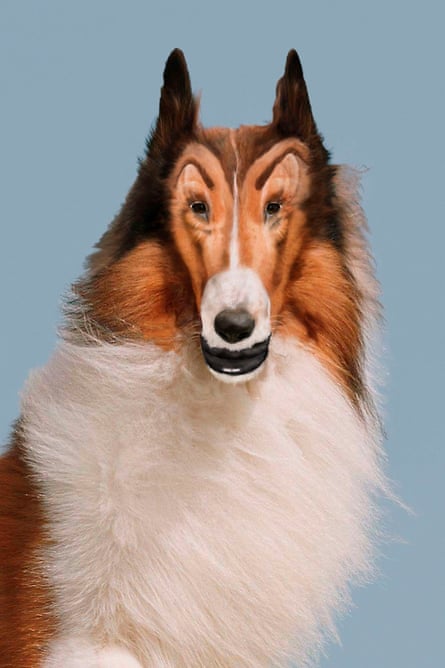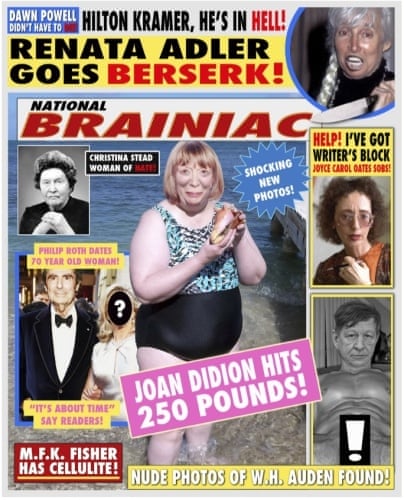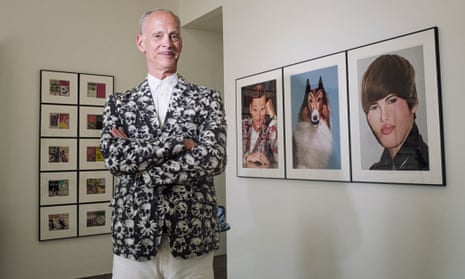I am looking at a disturbing self-portrait of John Waters. He’s wearing a tan uniform and, as if that weren’t bad enough, a matching baseball cap and a diabolical grin. In one hand, he’s holding a catching pole and, in the other, there’s a blameless mutt looking through the grille of its portable prison. The man they call the Pope of Trash has become a dog-catcher.
What’s that about, I ask the 69-year-old film director and artist as we stroll around the Sprüth Magers gallery, which is hosting his first London exhibition. “I wanted to be the most despised person imaginable, like I was when I started. I asked myself, ‘Who would that be today?’ The dog-catcher.” Waters spends his summers in Provincetown, Massachusetts, America’s most dog-friendly town. It was there that he borrowed the dog-catcher’s outfit and a small dog for the self-portrait.
“People looked at my early pictures and called them the most disgusting things ever and now Hairspray” – his 1988 musical love letter to racial integration and his native Baltimore – “is being done at every school in Britain and America. So things have changed. But I haven’t. So it’s nostalgia for being hated.”
Did you like being hated? “I built a career out of it. I wasn’t hated by the people I wanted to like my work – I was hated by the people it was bait for.” He’s thinking, no doubt, of films such as 1972’s Pink Flamingos which, after scenes featuring heroin-dealing, cop-murdering, masturbation, singing anuses and cannibalism, ends with the heroine (played by drag queen Divine) eating dogshit to prove that she’s the filthiest person in the world. Variety called it “one of the most vile, stupid and repulsive films ever made”.
“No critic would say that today because they’re too hip,” says Waters. So in a way you don’t like being celebrated? “No! I think it’s all delightful. It’s like being alive at your funeral. You get to hear the nice things people say. It’s great.”
He only wishes his mother were alive to be in London, not just for this debut art show but for his British Film Institute retrospective in September. “She was a huge anglophile. She went to English villages to watch birds and wear sensible shoes. She would have loved it. One time when I did The Graham Norton Show, I brought my mom over and she had a great time.”

A mood of nostalgia permeates the exhibition. I ask him to explain an image of a crab. “There’s no such thing as crabs any more because young people don’t have pubic hair any more. So where did they all go? They’re extinct! So I had to bring them back.” He stands back from the image to get a better view. “It’d take a brave collector to hang that above their couch. I’d rather have crabs than bedbugs. You can get rid of crabs in a day.”
Waters is not just nostalgic for being hated then, but nostalgic for old school STDs. Another piece called Poultry consists of covers of old gay porn novels with the word “chicken” in the title and depicting young, nubile gay men in various states of rudery. Each book is from Waters’ extensive collection. “I guess nobody says chicken any more in that context,” says Waters wistfully. “Now the gay slang is twink.”
And then there’s the stroller I stumbled across when I entered the show. The restraining straps look like they’re from a bondage fetishist’s closet, and the seat is decorated with the names of gay clubs including The Toilet and Blow Buddies, the latter with its striking logo of a penis in mid-ejaculation. If only, I think, the gallery had a gift shop, this baby buggy would be a top seller.
This stroller, too, is nostalgic. “Those are all real places that existed in the 60s and 70s. But today in those neighbourhoods, like the Castro district in San Francisco, you see gay couples with strollers with kids. Who’d ever have thought it would happen?” Blow Buddies, I’m happy to relate, still thrives in San Francisco. “So I’m just putting them both together to celebrate the gay world and show things change and become even more confusing.”
Waters started making art in 1992 and brought to it the black comedy and transgressiveness of his film work. When I put this to him, he says: “I didn’t even know that word, but yes, I’ve always been transgressive. When I went to Catholic high school they would let me read because it would shut me up and stop me causing trouble. And I sat there reading Jean Genet. They’d think, ‘Isn’t it nice he’s reading!’ and I’d be getting even more perverse ideas.”
Another exhibit, incidentally, purports to be a gravestone of his dead hero Genet. “The original was stolen the week after he was buried. And it’s never been recovered.” He pauses for effect. “And that’s it.” You’ve found it and are showing it here for the first time? Oh come on! “That’s what I’m saying.”
Even if he only started making art in 1992, it’s been part of Waters life for much longer. “I like art. It’s another way to rebel.” He has always collected art. “In the 60s, I got Jackie by Warhol for a hundred dollars.” It was a present from a girlfriend, I hear. “It was that long ago,” he laughs. One thing Waters isn’t nostalgic for is his straight old days.
We study a display of lurid paperback novels alongside their porn versions, all from Waters’s extensive library. Next to Chitty Chitty Bang Bang is Clitty Clitty Bang Bang. And why does the porn parody of Around the World in 80 Days have the same title as the original? “It’s sexual slang now, meaning that you lick everywhere,” he explains helpfully. “I believe that you’re never a classic in literature until they have done a porn parody. “
Why did he come to photography so late? Waters raises a sceptical eyebrow. “I use photography. I wouldn’t call it photography. I’m not Ansel Adams.” What he does, rather, is repurpose photography. Adams is a case in point. In the show, there is a series of Adams’s sublime nature photographs edited by Waters. In one, an airliner is crashing into a lake; in another, a tower block is ruining the view of a mountain range; and in a third, there’s a masked weirdo giving the camera the finger from a sylvan glade. The title? Cancel Ansel.

But, as with most of the work in this show, the humour is affectionate. “At the time these photographs are what made photography considered fine art. Now it’s the opposite of what photography is. It’s absolutely not about technique, right? So I had to go back to Ansel and make him more contemporary.”
When I suggest that Waters’s art is more like that of an editor, he agrees readily. “I wish,” he says, “I had been the editor of a tabloid for intellectuals.” In a sense, he has. One piece in the show is the cover of his version of the National Inquirer called National Brainiac. “Nude Photos of WH Auden Found!” bawls the headline next to a picture of the poet reclining naked with a chaste exclamation mark over his manhood. The main cover image depicts one of America’s great writers as you’ve never seen her before: “Shocking new photos! Joan Didion hits 250lbs!” That really is Joan Didion, buried deep in Photoshop,” says Waters. “I heard she laughed when she saw it.” Again, Waters insists the satire is affectionate. Really? I can’t imagine Philip Roth laughing about the coverline: “Philip Roth Dates 70-year-old Woman! About Time say Readers!” “I think he would,” says Waters. He looks at the National Brainiac cover one more time, adding: “I love every one of these people.”
As we stroll around the gallery, Waters in his pencilled-on moustache and a jacket with a skulls and flowers print motif, we can hear the voices of children. They’re coming from an installation called Kiddie Flamingos in which some Baltimore children (“They’re not actors, just friends’ kids”), the youngest six, sit around a table reading the script of Pink Flamingos. The script, like all of Waters’s raw material, has been heavily edited. At the end, for instance, the heroine is supposed to eat not dog faeces but dog food. “Ewwwww!” howl the pre-pubescent kids as the credits roll over a freeze frame of the heroine pretending to eat dog food. “Waters hopes that this defanged and desexualised sequel is yet more perverse than the original,” says the press release.

Can he imagine doing art that didn’t have anything to do with movies or show business? “Yes, but I can’t imagine doing art that didn’t have some kind of humour in it.” He thinks he is bringing something new to art. “Can art be funny? It can be witty, but can it be funny? I think yes but people are nervous. They’re not used to it.” They might also be queasy about Waters’s bad taste. In one image, the Kennedys are descending the steps from Air Force One on that fateful day in Dallas, 1963. Behind them on the steps is the Grim Reaper from Bergman’s The Seventh Seal, scythe aloft. “The people in America that might be offended don’t go to my shows. It’s not mean. It’s just a Bergman way to look at what happened. I mean Death was following them that day.”.
My favourite pieces are three images hung together depicting plastic surgery gone wrong. Let me thank you for introducing me to a new experience, I say to Waters. “Huh?” I’d never fancied Justin Bieber until I saw your image of him. In Justin’s Had Work, he’s Photoshopped plump, Angelina Jolie-esque lips on to the pop star and given him stirringly come-hither brown eyes. “His mouth looks like an anus,” giggles Waters. “I’m a Justin fan you know.”
Next to Bieber is a Photoshopped Lassie who’s had work on lips and cheekbones. And next to Lassie is Waters with, as he puts it, “bad wig, way too much velour, trout pout, drawn-on eyebrows. In Beverly Hills, some people would say that looks good. Their weird is different from ours.” The image is called, like the show, Beverly Hills John. In reality, Waters confides, the only work he’s had done is on his teeth. “At my age you can go either fat or gaunt. I’ve gone gaunt.”
Why Lassie? “Well, old people and young have work done. What’s the next step? Pets.” Probably even now, on some chop shop in Rodeo Drive, a collie is going under the beautifying knife.
One last piece. On the wall is a huge ruler called 8½, measuring out eight and half feet. When Waters went to the Baltimore premiere of Fellini’s 8½ in the early 60s, the Charles theatre handed out little 8½ inch rulers to cinemagoers. He still has the original at home. “I loved that movie. Fellini was a little lofty for a teenage boy but certainly he was a huge influence.” Why? “We used to watch his movies tripping on acid. Juliet of the Spirits is the best tripping film.” Good tip.
“He inspired me because he had a local cast in his movies, people who typically weren’t movie stars. That’s what I did too.” He waves his arms around the exhibition, like the showman that he is, embracing high art and low trash in one gesture. “Fellini, Warhol, Bergman – and nudist camp movies! They’re all in here!”

Comments (…)
Sign in or create your Guardian account to join the discussion